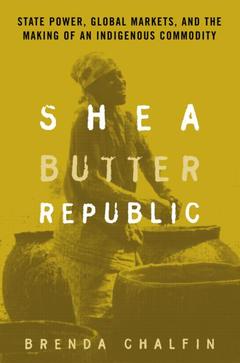Description
Shea Butter Republic
State Power, Global Markets, and the Making of an Indigenous Commodity
Author: Chalfin Brenda
Language: English
Subjects for Shea Butter Republic:
Keywords
Shea Nuts; Shea Butter; nut; Shea Market; economy; Shea Economy; tree; Commercial Shea; market; Shea Trade; production; Shea Butter Products; northern; Northern Ghana; savanna; Butter Production; zone; Shea Trees; commercialization; Cocoa Butter Substitute; processing; Nut Traders; Butter Processing; Cocoa Marketing Board; PBC; Commercial Butter; Colonial Administration; Shea Production; Dawa Dawa; Shea Processing; Cocoa Butter; Shea Butter Processing; Gold Coast Colony; Chocolate Directive; West African Produce Control Board
Publication date: 02-2004
· 15.2x22.9 cm · Paperback
Publication date: 01-2004
· 15.2x22.9 cm · Hardback
Description
/li>Contents
/li>Biography
/li>Comment
/li>
Shea butter (butyrospermin parkii) has been produced and sold by rural West African women and circulated on the world market as a raw material for more than a century. Shea butter has been used for cooking, making soap and candles, leatherworking, dying, as a medical and beauty aid, and most significantly, as a substitute for cocoa butter in chocolate production. Now sold in exclusive shops as a high-priced cosmetic and medicinal product, it caters to the desire of cosmopolitan customers worldwide for luxury and exotic self-indulgence. This ethnographic study traces shea from a pre- to post-industrial commodity to provide a deeper understanding of emerging trends in tropical commoditization, consumption, global economic restructuring and rural livelihoods. Also inlcludes seven maps.

